Seakeeper 4 / 4.5 Installation Manual (90762-1)
Seakeeper 4 / 4.5 Installation Manual (90762-1)
1.0 Introduction
Seakeeper 4 / 4.5
Installation Manual
90762, revision 1

This installation manual is intended to provide details and guidance to a boat builder
or equipment installer to install the Seakeeper 4 and Seakeeper 4.5 Stabilization Systems
(Serial number 4-0001 and 4.5-0001 to current).
Reference Documents:
- 90737 – Seakeeper 4.5 Hardware Scope of Supply
- 90807 – Seakeeper 4 Packing List
- 90806 – Seakeeper 4.5 Packing List
1.1 Precautions

There is a significant torque about the gimbal axis when the
Seakeeper is precessing. Seakeeper cover panels are provided to prevent personnel or equipment from contacting the Seakeeper while in operation. These covers should not be stepped on or have anything placed on top. The covers should always be in place during operation.
__________________________________________________________________________________________
If it is ever necessary to access the Seakeeper while the flywheel is pinning, the Seakeeper must be locked at the display to stop the Seakeeper from precessing.
__________________________________________________________________________________________
Stand clear of the Seakeeper and all moving components.
__________________________________________________________________________________________
The unit may be started remotely. Assume it could move without warning.
__________________________________________________________________________________________
The following must be true before accessing the Seakeeper:
* The Input power must be disconnected for at least 10 minutes
* The Seakeeper must be locked (Not in SEA MODE)
* The Flywheel must be at zero speed
- The Seakeeper must only be lifted from the supplied lifting eyes (see Section: Transport and Unpacking).
- Precision bearings support the Seakeeper flywheel. Make sure while unpacking and lifting the Seakeeper assembly NOT to drop or impart mechanical shock as damage to bearings could result.
- While handling / installing the Seakeeper assembly, protect exposed hydraulic brake cylinder rods (See Figure 1) from scratches or damage, which could lead to premature seal failure and oil leaks.
- While handling / installing the Seakeeper assembly, do not allow electrical fittings that exit the bottom of the Seakeeper enclosure to contact any surface or object. Damage to the fittings could potentially affect the vacuum integrity of the enclosure.
- Exercise care to protect the painted finish, as damage to the finish could lead to early appearance degradation of the installed Seakeeper.
1.2 Transport and Unpacking
Reference Documents:
- 90808 – Seakeeper 4 & 4.5 Unpacking Instructions
- 90807 – Seakeeper 4 Packing List
- 90806 – Seakeeper 4.5 Packing List
1.2.1 Transport
- Use a Seakeeper provided shipping crate for transport (P/N 90810). Overall dimensions of a fully packed crate are xx.x L X xx.x W X xx.x H in. (x.xx L X xx.x W X xx.x H m) with a weight of xxx lbs (XXX kg).
- Do not stack Seakeeper shipping crates.
- Both Air and Ground transport are acceptable.
- Seakeeper shipping crates must be transported in environmental conditions between 32°F and 140°F (0°C and 60°C).
1.2.2 Unpacking Crate
- Reference Seakeeper Drawing No. 90737 – Seakeeper 4.5 Hardware Scope of Supply for items that ship with the Seakeeper.
- Remove electrical components, cables, and miscellaneous items and set aside.
- Remove packing materials that secure the Seakeeper assembly inside the crate.
- Remove top and angled face cover panels to access lifting eyes.
- Attach spreader bar (P/N 11766) to the two lifting eyes located on the top of the Seakeeper enclosure. Stay clear of any other parts on the Seakeeper. The Seakeeper 4.5 weighs 728 lbs (330 kg).

2.0 Mechanical Installation
2.1 Mechanical Installation Introduction
The Seakeeper 4.5 can produce loads up to 2989 lbs (13.30 kN) at each mount. These forces should be considered to be acting simultaneously, fully reversing, and will repeat an infinite number of times. Careful consideration should be given to foundation design to ensure it can transfer these loads into the hull. These loads do NOT include vessel motion accelerations, such as vertical slam loads, which can be significant for higher-speed vessels. The responsible party for designing the supporting structure (boatbuilder, installer, or hired sub-contractor) must accommodate the above forces plus a reasonable safety factor. Seakeeper recommends a minimum safety factor of 3.0 (yielding a Safety Margin of 2.0).
It is assumed that the installer is familiar with installations using mechanical fasteners to marine structures and has performed structural analysis to ensure the structure to which the Seakeeper mounts can adequately transfer the loads the Seakeeper creates into the hull structure. If the installer has any doubt about the ability of the structure to transfer the loads to the hull, then a licensed naval architect or marine engineer should be contacted to do a structural analysis.
The installer should review the following list of reference drawings to ensure the installation procedure and structural requirements are fully understood.
Reference Documents:
- 90737 – Seakeeper 4.5 Hardware Scope of Supply
- 90726 – Seakeeper 4.5 Bolt-In Installation Drawing
- 90736 – Seakeeper 4.5 Generic Installation Guide
- 90803 – Seakeeper 4.5 Bolt-In Clearances
- 90804 – Seakeeper 4 / 4.5 Blind-Hole Installation Kit
- 90805 – Seakeeper 4 / 4.5 Thru-Hole Installation Kit
- 90819 – Seakeeper 4.5 Installation Template
2.2 Selection of Installation Location

Seakeeper can only assess installation location regarding its impact on Seakeeper operation and serviceability. Seakeeper cannot determine how the installation location will affect the vessel’s static or directional stability other than cyclic roll reduction. The Installer is responsible for considering the Seakeeper‘s effect on the CG location, trim, overall stability, and vessel performance.
Selection of mounting location of Seakeeper should consider the following desirable features:
- Consider overhead access or sufficient clearance for removal / re-installation of the Seakeeper for an overhaul in future years. Also, provide adequate clearance for maintenance, as shown in Figures 1 and 2 below.
- The minimum service clearances shown are based on the size of serviceable components and tools required for removal and replacement of these components. The clearances do not consider how the technician will be positioned for access to these areas. Access for a technician must be considered by the installer.
- The clearance and access requirements do not need to be permanent and can be provided via hatches, removable panels, or other temporary means where applicable.
- The installer/designer should consider all these factors for serviceability when defining the installation arrangement.
- Top down access must be incorporated into installation design to allow for adequate regular maintenance, service, and repair.
- The Seakeeper should be installed in a dry space to minimize the effects of corrosion.
- The Seakeeper should be installed near vessel’s longitudinal center of gravity (LCG) to minimize the effects on trim and performance in various loading conditions.
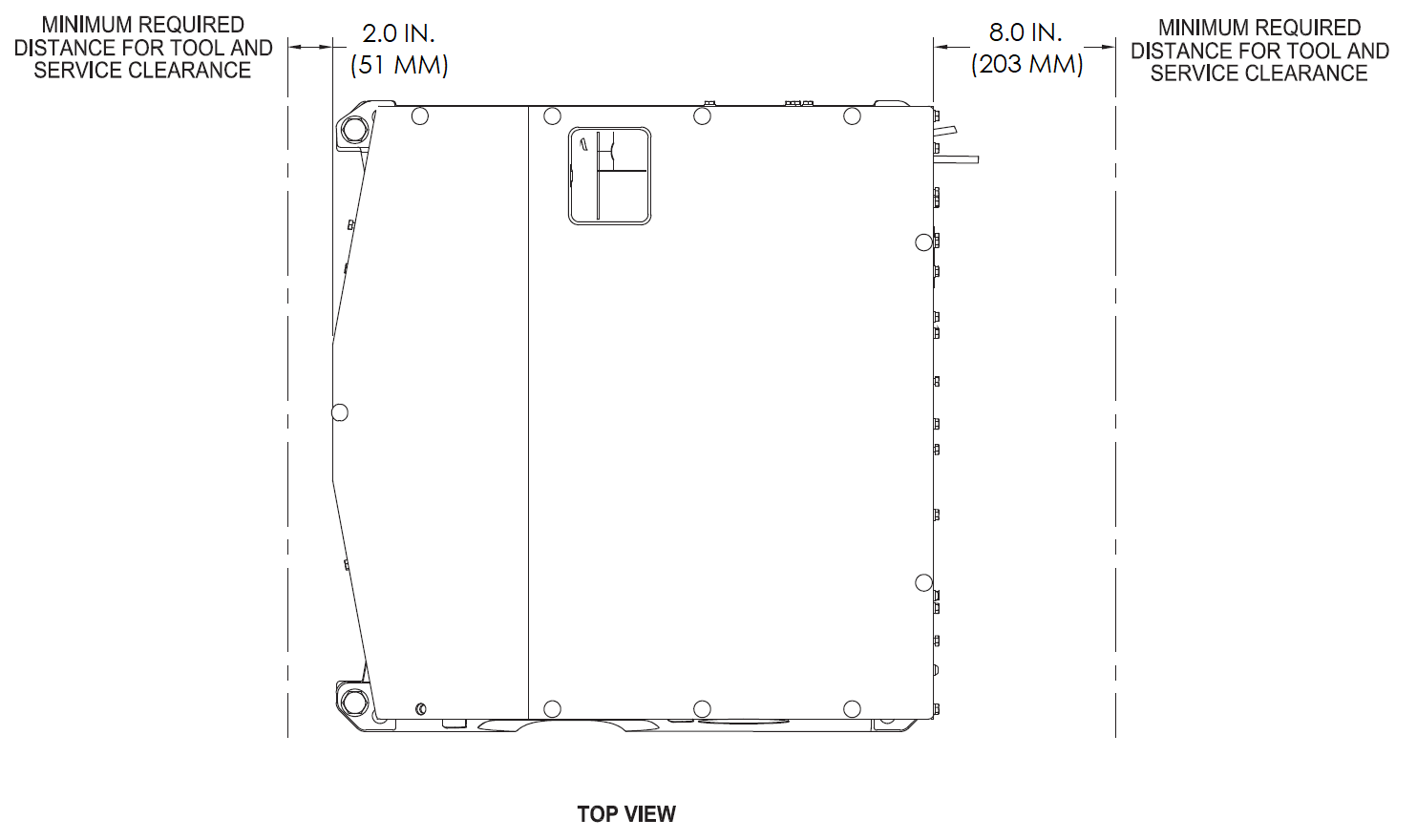
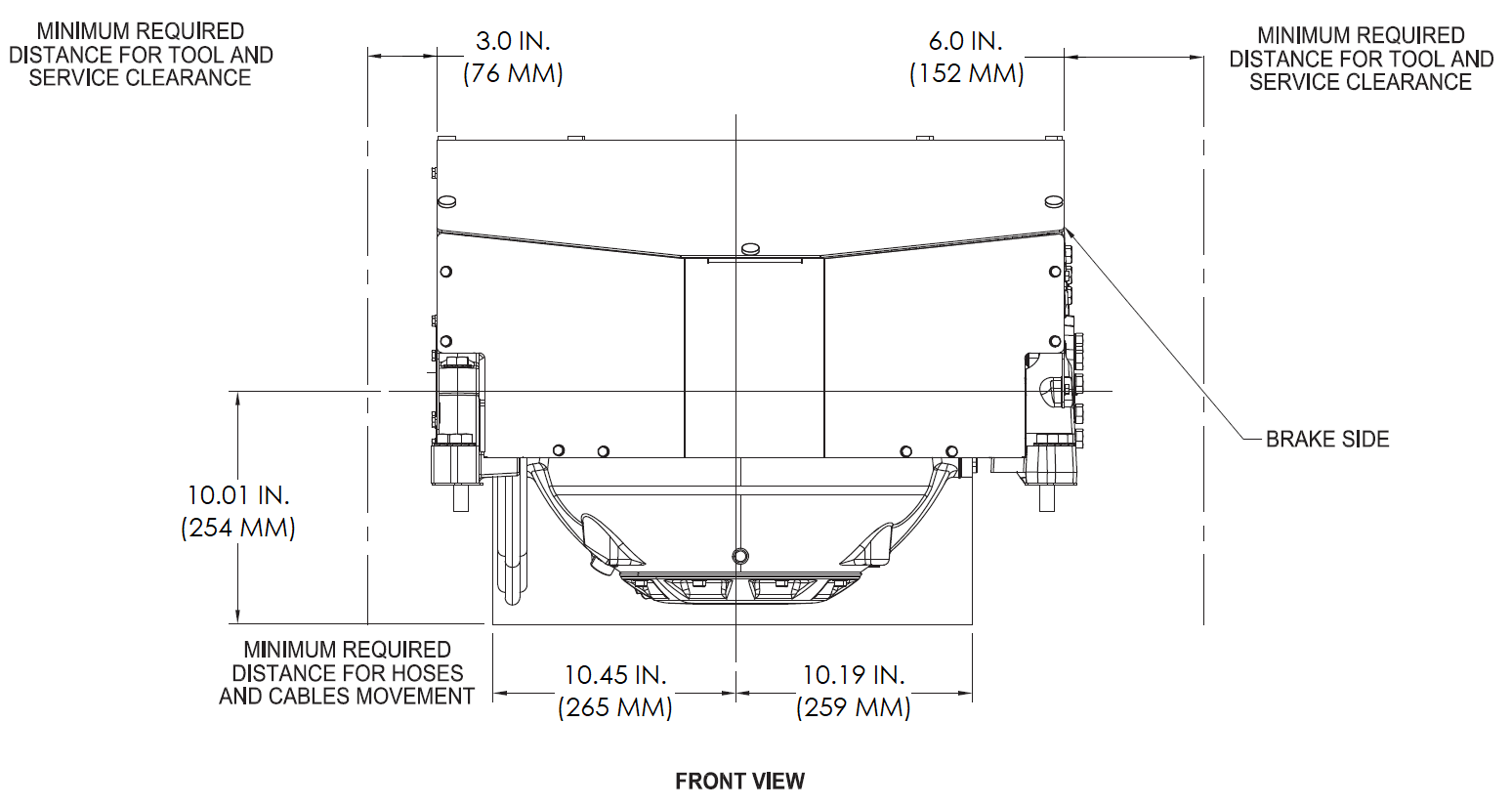

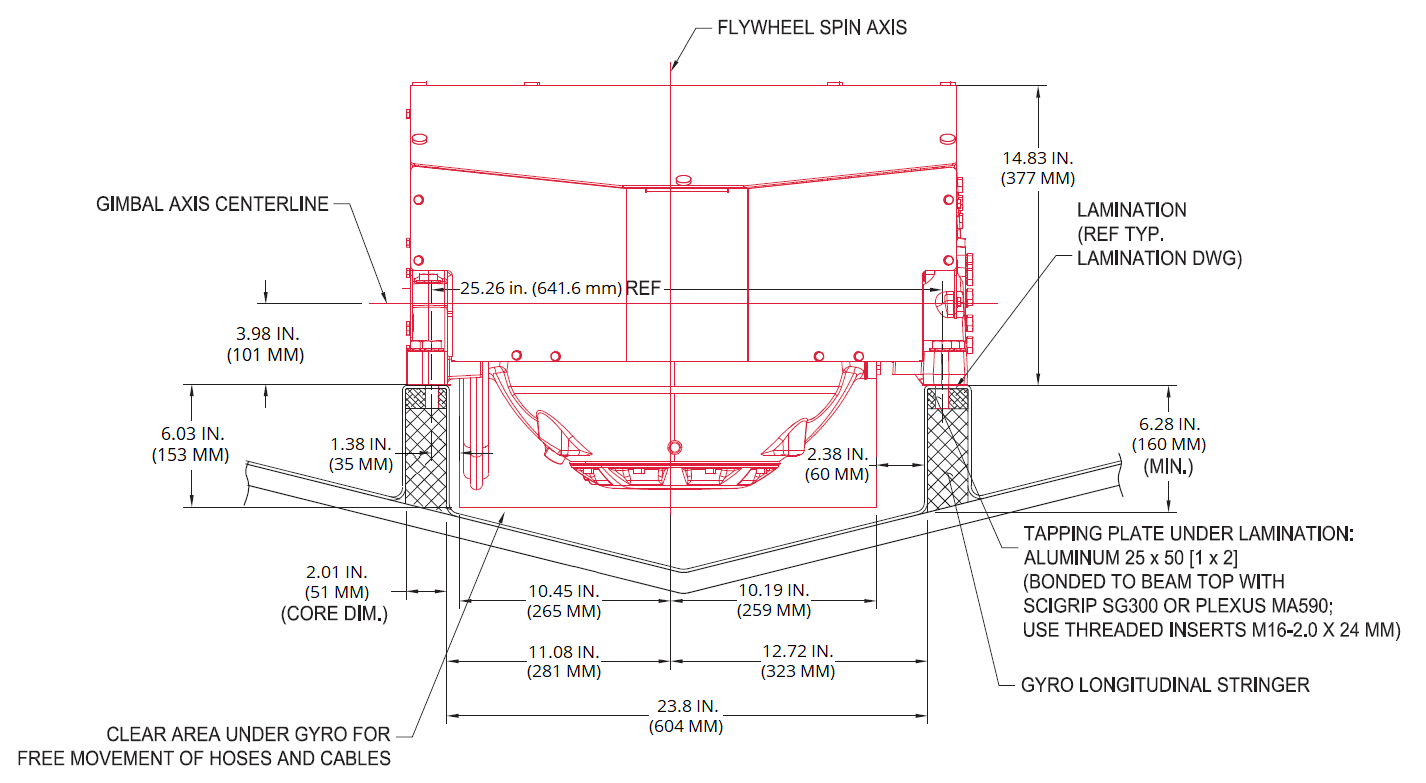
2.2.1 Noise / Soundproofing
Seakeeper noise has been measured under steady state conditions (no wave load) in Seakeeper‘s Engineering Lab and in our Factory Demo Boat. The steady state noise is typically <72 dBC at 1 meter. As the frequencies emitting the highest sound pressures are low (like other marine machinery), it is recommended that the
Seakeeper be installed in a machinery space that is already treated with soundproofing.
2.3 Bolt-In Installation
2.3.1 Preparation of Boat Structure
The Seakeeper Drawing No. 90736, Seakeeper 4.5 Generic Installation Guide shows various structural arrangements to support the installation of the Seakeeper 4 / 4.5. The Generic Installation Guide offers above and below deck installation arrangements with fiber reinforced plastic (FRP) and aluminum structures, which should provide solutions for most vessels. The Seakeeper 4 / 4.5 is affixed to the hull structure via eight bolts in the Seakeeper frame. Depending on the structure to which the Seakeeper is fastened, blind threaded holes or through-bolting can be utilized.
Refer to Seakeeper Drawing No. 90736, Seakeeper 4 / 4.5 Bolt in Installation Guide. Important dimensional and load information is given in this drawing that will impact the design details of the structure that will receive the Seakeeper. It is assumed that a proper structural analysis has been performed for the hull structure to which the Seakeeper will be fastened to ensure proper strength margins for the loads the Seakeeper will create during operation.
The hull structure supporting the Seakeeper should be installed so the Seakeeper is parallel to the waterline in the transverse direction and within 2 degrees longitudinally.
In addition, the four areas on top of the structure on which the Seakeeper frame and isolation gaskets will rest, need to be co-planar within .06 in. (1.5 mm) to minimize potential distortion of the Seakeeper support frame when installed. The isolation gaskets are only used when the Seakeeper is mounted to a dissimilar metal structure.
Seakeeper offers an optional installation template kit, P/N 90819, which contains four plates that mimic the mating surfaces of the four feet located on the Seakeeper’s foundation. These plates have eight holes located at the same centers as the mounting holes on the Seakeeper. The fixture locates the hole patterns at the proper spacing both in the forward-aft direction and the port-starboard direction. Once assembled, the fixture can be used to check clearances and alignment of the hull structure.
Note: Do NOT use the installation fixture to establish the Seakeeper envelope dimensions. Refer to Drawing No. 90726 – Seakeeper 4 / 4.5 Bolt-In Installation Details, for envelope dimensions. A 3-D model of the Seakeeper is available on the Seakeeper Dealer Access website (www.seakeeper.com) to aid in designing the Seakeeper foundation and the space around the Seakeeper.
NOTE: MAKE SURE NO OBSTRUCTIONS FROM THE HULL STRUCTURE CAN BE SEEN WITHIN
THE INSIDE OF THE INSTALLATION TEMPLATE KIT. REFERENCE SEAKEEPER
DRAWING NO. 90726 – SEAKEEPER 4 / 4.5 BOLT-IN INSTALLATION DETAILS
2.3.2 Transfer of Holes to Boat Structure
- Lower installation template fixture onto hull structure.
- The four areas where the feet of the Seakeeper will rest should be coplanar to within 0.06 in. (1.5 mm).
- Align fixture in desired location and transfer holes from fixture plate to the hull structure.
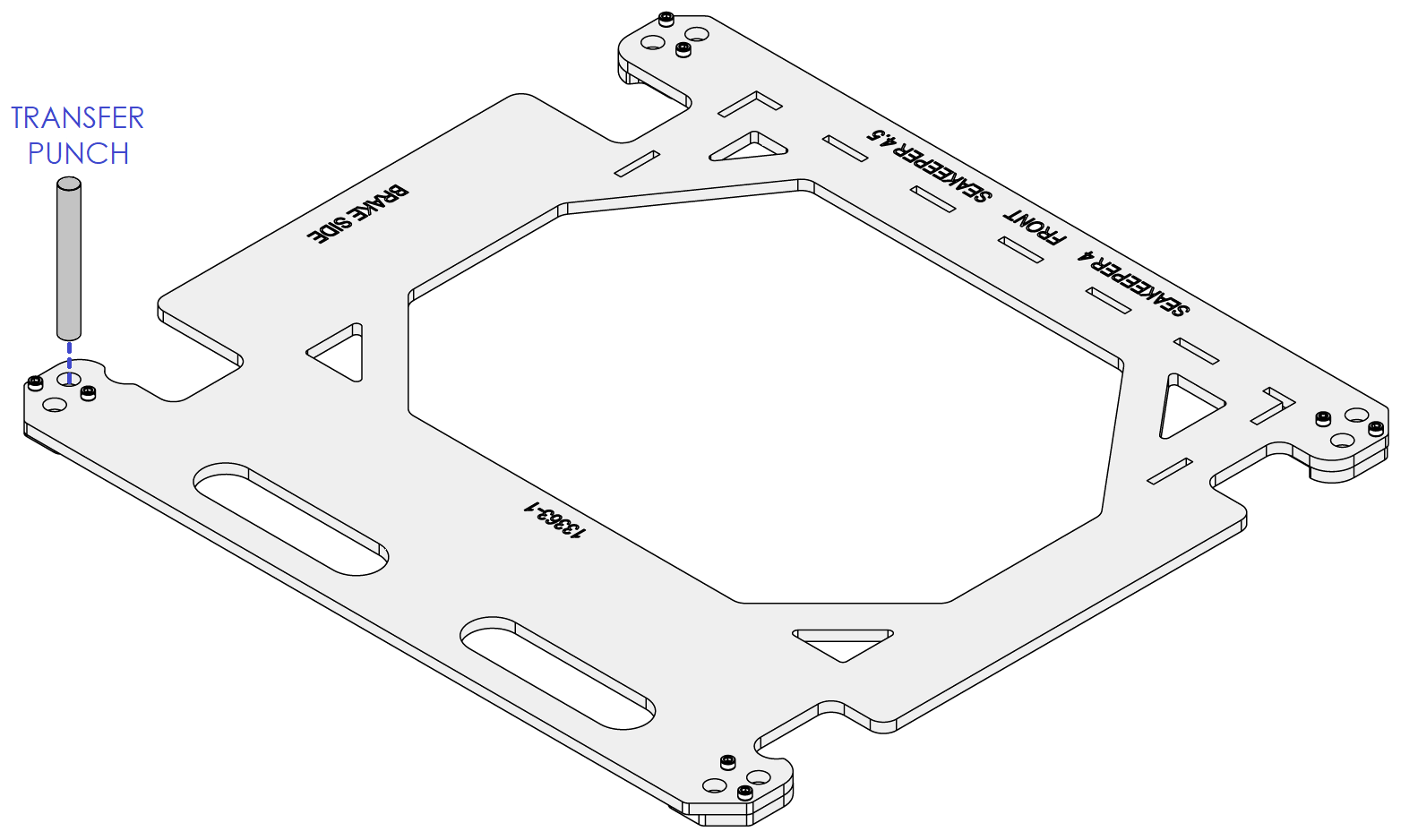
Blind Hole Installation
- Remove Template Fixture and drill eight (8) 0.625 in. (15.875 mm) holes perpendicular to the vessel structure to a minimum depth of 1.25 in. (31.75 mm). Take special care to drill perpendicular to mounting surface. A drill guide is recommended. Remove any impeding obstructions.
- Tap drilled holes for helical thread inserts per documentation accompanying helical thread inserts.
- Install eight (8) M16 – 2.0 X 24 mm threaded inserts into holes in hull structure at drilled and tapped locations using thread insert manufacturer provided installation tool.
- Remove thread insert prong / tang after thread inserts are installed.
- Lower Seakeeper 4 / 4.5 onto stringer over prepared holes.
- Install fastener hardware per installation drawings.
- Torque fasteners to 155 ft-lbs (210 Nm).
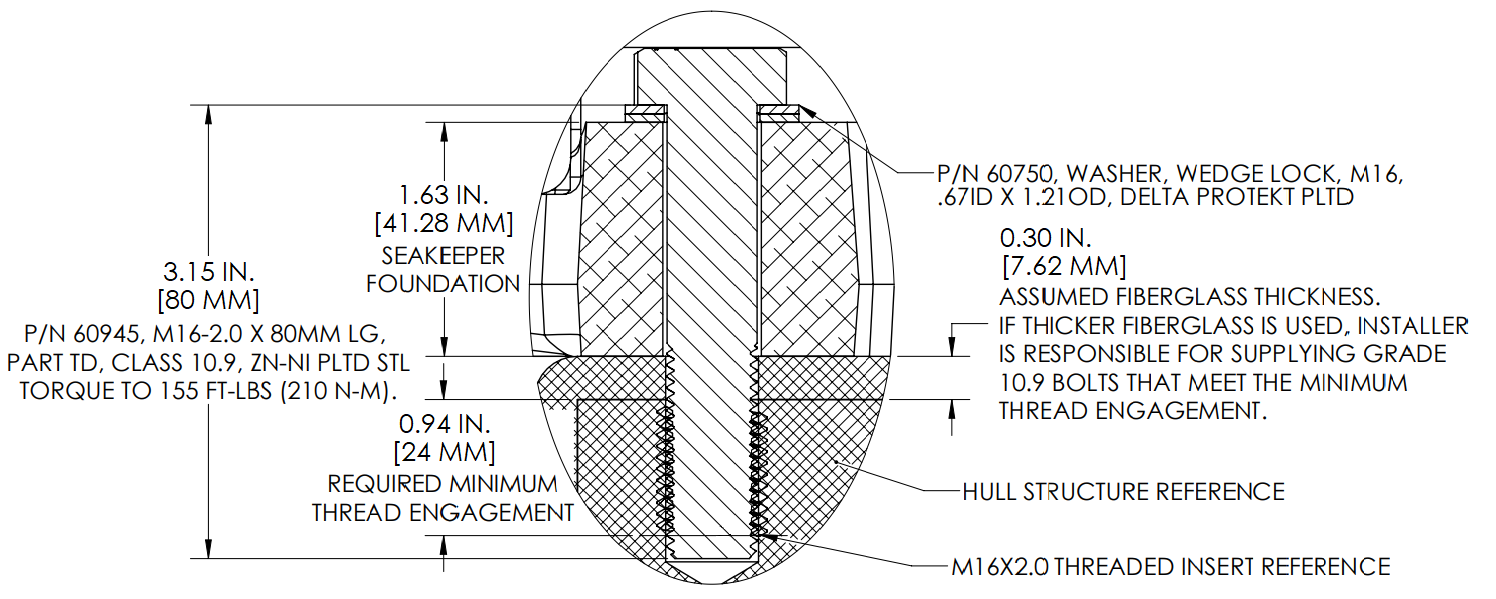
Through-Hole Installation
- Remove Template Fixture and drill eight (8) 0.669 in. (17 mm) ø holes perpendicular to the vessel structure. Take special care to drill perpendicular to mounting surface. A drill guide is recommended.
- Lower Seakeeper 4 / 4.5 onto structure over prepared holes.
- Install fastener hardware per installation drawings.
- Torque fasteners to 155 ft-lbs (210 Nm).
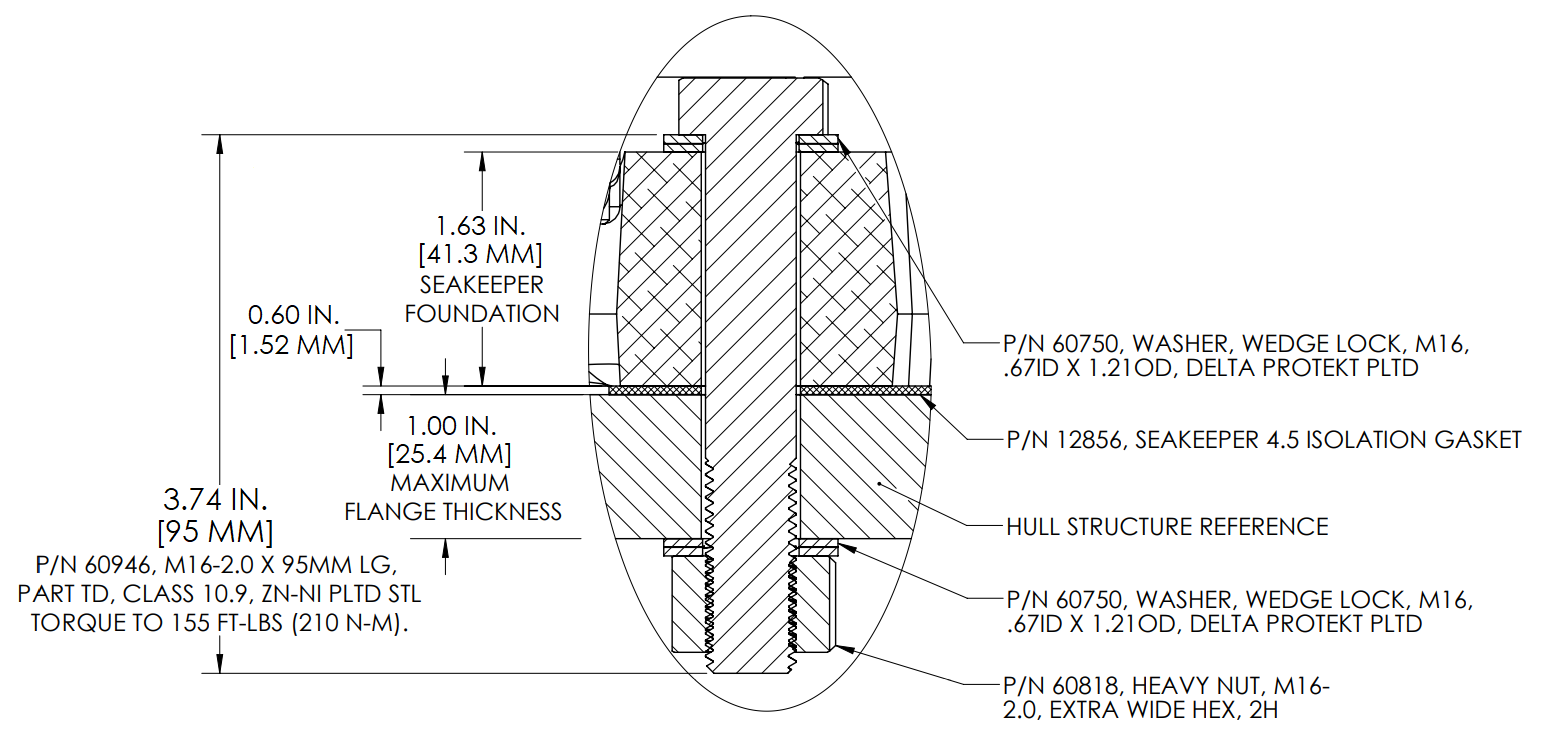
2.3.3 Installation of Seakeeper
- Lower Seakeeper into position onto the hull foundation beams and align over drilled holes. Apply a small bead of marine sealant (e.g., SILI-THANE 803 or equivalent) between mating surfaces of Seakeeper frame and hull structure to prevent moisture wicking into bolt holes.
- For dissimilar metal foundations, locate and position four isolation gaskets onto foundation beams and apply a small bead of marine sealant (e.g., SILI-THANE 803 or equivalent) between both mating surfaces of each isolation gasket where it contacts the beam and the Seakeeper.
- Install mounting fasteners:
- For Blind Hole installations, install the Seakeeper supplied Grade 10.9, Mxx-x X xx mm fasteners to maintain a minimum thread engagement of 0.xx in (xx.xx mm). Apply a moderate coat of nickel-based anti-seize (e.g., SAF-T-EZE nickel grade anti-seize, SBT-4N, or equivalent) to the threads of each bolt and include a small bead of marine grade sealant (e.g., SILI-THANE 803 or equivalent) under each bolt head and washer before installation.
- For Through-Bolt installations, install the Seakeeper supplied Grade 10.9, Mxx-xx X xx mm fasteners with a minimum of 2 threads passing through the nut. Apply a moderate coat of nickel-based anti-seize (e.g., SAF-T-EZE nickel grade anti-seize, SBT-4N, or equivalent) to the threads of each fastener and include a small bead of marine grade sealant (e.g., SILI-THANE 803 or equivalent) under each bolt head and washer before installation.
ADD IMAGES HERE
- Torque all fasteners to XXX ft-lbs (xxx Nm).
- New bolts, matching the Seakeeper specification, must be used for each installation that meet the requirements listed above.
- Proceed to electrical and cooling installation.
3.0 Electrical Installation
3.1 Electrical Installation Introduction
This section for electrical installation explains how to mount the electrical equipment and connect the electrical cables.
Reference Documents:
- 90737 – Seakeeper 4.5 Hardware Scope of Supply
- 90696 – Seakeeper 4.5 Cable Block Diagram
- 90699 – Seakeeper 4 Cable Block Diagram
- TB-90191 – Seawater Cooling Pump Recommendations
- TB-90621 – Seakeeper Battery Sizing Recommendations
- TB-90640 – ConnectBox Connection Requirements
- Seakeeper MFD Compatibility Technical Bulletins:
- Optional 5″ Touch Display
Because of the different motor power requirements between Seakeeper 4 and Seakeeper 4.5, the Motor Power Connections are separated into independent subsections (Sect. 3.2.1 and 3.2.2). The Control Power, Seawater Power, Ground, and ConnectBox connection requirements (Sect. 3.3 through 3.6) are the same for both models.
The following images show the electrical equipment included with the Seakeeper 4 and 4.5 Hardware Scope of Supply (Drawing No. 90737):
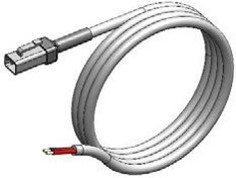
16.4 ft (5 m), P/N 20248

16.4 ft (5 m), P/N 30327
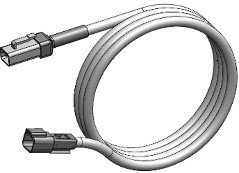
16.4 ft (5 m), P/N 20334
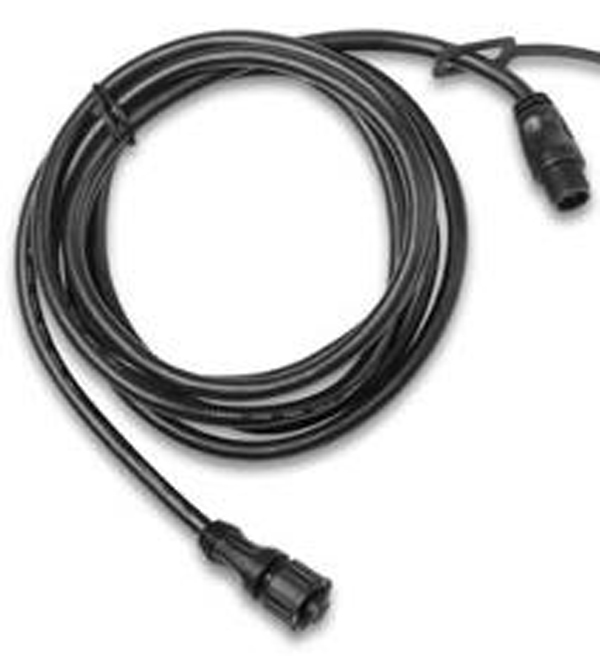
19.7 ft (6 m), P/N 30332
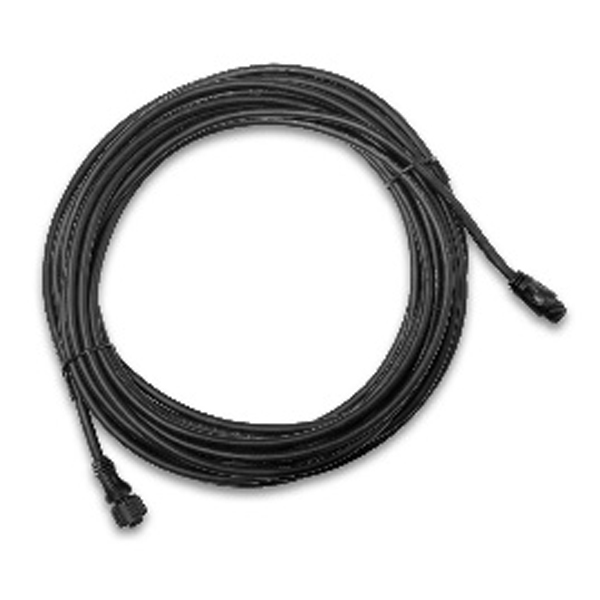
32.8 ft (10 m), P/N 30330
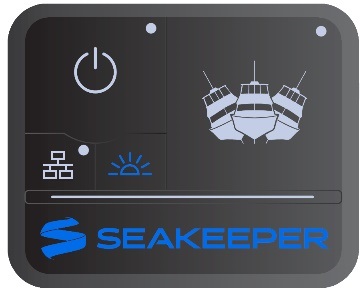
3.2 Motor Power Connections
3.2.1 Seakeeper 4 Motor Power Connection

Reversing polarity on the DC power input to the Seakeeper can result in damage to electronics in the control system.
High Current 12 VDC Power Source Requirements
- One 12 VDC, 100 A (Customer supplied) for Seakeeper flywheel motor power.
- A dedicated breaker should be used for each Seakeeper in a multiple Seakeeper installation.
High Current 12 VDC Power Connection
- Connect high-current power red and black cables, 2 AWG conductors, to the 12 VDC power source.
- Both cables (red and black) are supplied at length 13 ft (4 m) and approximately 0.5 m is routed within the gyro frame.
- Connect high-current power positive (B+, red) conductor through 100 A overcurrent protection device, dedicated battery isolation switch (customer supplied), and to battery positive (B+) terminal.
- Connect high-current power negative (B-, black) conductor directly to battery negative (B-) terminal or to vessel main negative bus.
- If the 2 AWG high current 12 V power input conductors are shortened or lengthened, use heavy-duty eyelet (closed end) terminal such as Molex 19221-0235 and follow instructions outlined in the following steps.
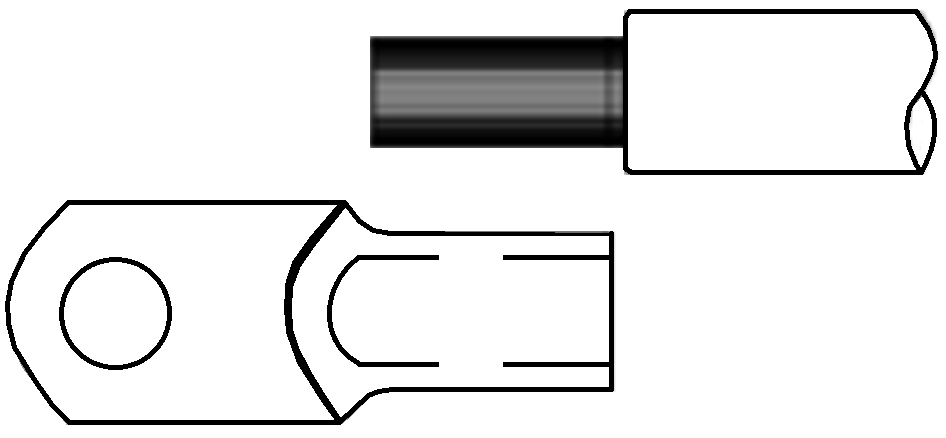
- The bare wire strands should extend fully into the barrel of the heavy-duty eyelet and be crimped in two places if possible then sealed with double-wall heat shrink tubing. Crimp heavy-duty terminals with Quick Cable 4245 Crimp Tool, Molex19284-0034 Crimp Tool, or equivalent using manufacturer’s instructions.

- Use heavy-duty eyelet (closed end) terminal such as Molex 19221 – Strip insulation from 2AWG conductor to the length of the terminal barrel approximately as shown.

- Insert stripped end of 2 AWG conductor fully into barrel of heavy-duty eyelet (closed end) terminal, approximately as shown.

4. Crimp with quick cable 4245 cub crimp tool or equivalent, double
crimp, as shown.
- The resultant crimp(s) should fully enclose and confine the conductor strands from all sides and withstand an aggressive manual pull test.

- Install approximately 1.5 in. (38 mm) of double wall (adhesive lined) heat shrink tubing over both the terminal barrel and the conductor insulation. Heat shrink in place until tubing conforms to barrel and conductor shape and adhesive seals the junction (See figure below).
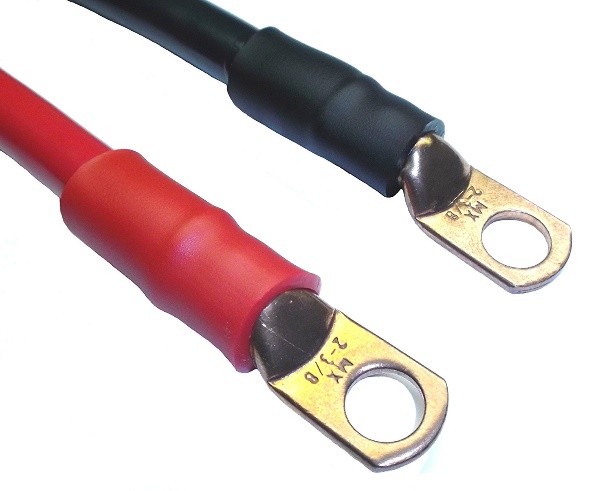
3.2.2 Seakeeper 4.5 Motor Power Connection
AC Input Power Source Requirements
- Either of two AC input voltages are acceptable:
- 110 – 120 VAC (nominal) (+/- 10%), 1 Phase, 50/60 Hz, 30 A
- 208 – 230 VAC (nominal) (+/- 10%), 1 Phase, 50/60 Hz, 20 A
- A separate circuit breaker should be used for each Seakeeper Drive Box in multiple Seakeeper installations.
AC Power Input Connection Instructions
AC Input Cable (3 X 10 AWG or 3X 0.6mm2 CSA), 10 ft (3 m) length, Seakeeper supplied pre-installed.
- Locate AC Input Cable for AC power input to the Drive Box.
ADD IMAGE IF DESIRED (SHOWING AC CABLE OUT OF SK 4.5)
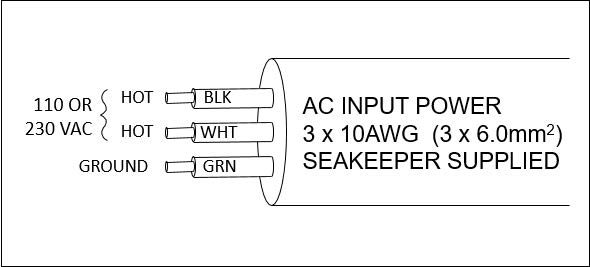
- Connect AC wires in to a 230 V, 20 A (or 110 V, 30 A), double-pole Circuit Breaker at an AC power distribution panel.
3.3 Control Power Connections

Reversing polarity on the DC power input to the Seakeeper can result in damage to electronics in the control system.
Low Current 12 V Power Source Requirements
- One 12 VDC, 15 A (Customer supplied) for Seakeeper Control Power.
- A dedicated breaker should be used for each 12 VDC load on the Seakeeper: one breaker for Control Power and one breaker for Seawater Pump power (Drawing No. 90696 and 90699).
- , A dedicated breaker should be used for each Seakeeper‘s Control and Seawater Pump power if multiple units installed.
12 VDC Control Power Connection
- Install Seakeeper provided DC Power Input Cable, P/N 20248 (Drawing No. 90696 and 90699).
- Route DC Power Input Cable to DC Power Distribution Panel.
- Terminate positive (B+, Red) conductor to +12 VDC.
- Terminate negative (B-, Black) conductor directly to battery negative or negative bus terminal.
- Before connecting DC Power Input Cable to Seakeeper wire harness, check for proper voltage and polarity with a multimeter using figure below.
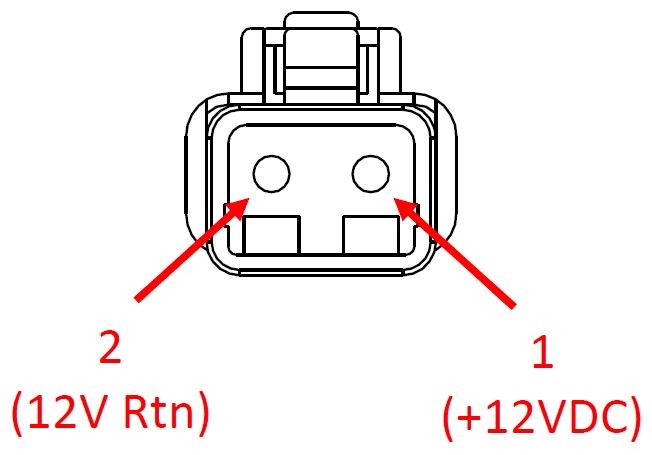
Contact Assignments (front)
- Connect control power cable to 12 VDC power input connector (labelled “INPUT POWER”) on the Seakeeper, Deutsch DTP04-2P connector.
3.4 Seawater Pump Power Connections

Reversing polarity on the DC power input to the Seakeeper can result in damage to electronics in the control system.
DC Seawater Pump Power Source Requirements
- One 12 VDC, 15 A (Customer supplied) for DC Seawater Pump.
- OPTIONAL: Seakeeper 4.5 may use one 24 VDC, 10 A (Customer supplied) source for the DC Seawater Pump.
- A dedicated breaker should be used for each 12 VDC load on the Seakeeper: one breaker for Control Power and one breaker for Seawater Pump power (Drawing No. 90696 and 90699).
- A dedicated breaker should be used for each Seakeeper‘s Control and Seawater Pump power if multiple units installed.
DC Seawater Pump Input Power Connection
- Install Seakeeper provided DC Seawater Pump Input Cable, P/N 30327 (as shown in Drawing No. 90696 and 90699).
- Route Seawater Pump Input Cable to DC Power Distribution Panel.
- Terminate 16 AWG positive (B+, Red) conductor through 12 VDC dedicated overcurrent protection device (customer supplied), maximum of 15 A, to dedicated battery isolation switch.
- 24 VDC, 10 max can be used for Seakeeper 4.5 Seawater Pump power.
- Terminate 16 AWG negative (B-, Black) conductor directly to battery negative terminal or DC main negative bus bar.
- Before connecting Seawater Pump Input Cable to Seakeeper wire harness (at “SW PUMP VDC IN”), check for proper voltage and polarity with a multimeter using figure below.

- Connect Seawater Pump Input Cable to “SEAWATER IN” connector on the Seakeeper wire harness Deutsch DT04-2P connector.
DC Seawater Pump Output Power Connection
- Connect Seawater Pump Output cable (P/N 20334) to the Seakeeper 4.5 “SW PUMP VDC OUT” connector.
- The Seawater Pump Output cable is a 2 X 16 AWG cable, 16 ft (5 m) length, with a size 16 female Deutsch plug.
- Pumps rated at 12 VDC, 15 A maximum (24 VDC, 10 A), customer-supplied, must be configured with a Deutsch DT series, 2-pin receptacle to mate with the connector shown in figure below.
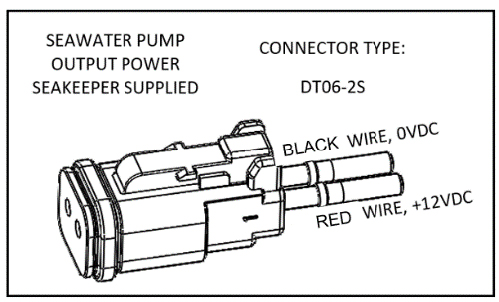
- The Seawater Pump Output cable must be routed and installed in the vessel from the Seakeeper “SEAWATER OUT” connector (male) to the DC seawater pump cable Deutsch connector (female).
- Connect Seawater Pump Output cable plug (female) to the customer-supplied receptacle (male). The recommended wiring is shown in figure below.
- Contact Seakeeper if desired to install customer-supplied relay on Seawater Pump Output cable to power Seawater Pump.

3.5 Electrical Equipment Ground Connections
- Connect the Seakeeper foundation ground to vessel ground as shown in figure.
- Install Ground Cable (10 AWG or 6.0 mm2, customer-supplied) from the M6 brass ground stud on the Seakeeper rear brace to a suitable vessel ground.
- EN/IEC 90204-1 Clauses 6.3.3 and 8.2.3
- ABYC E-11 July 2018 Clauses 11.5.2 and 11.16.1
NOTE: USE ONLY THIS LOCATION TO GROUND THE SEAKEEPER TO THE VESSEL GROUND.
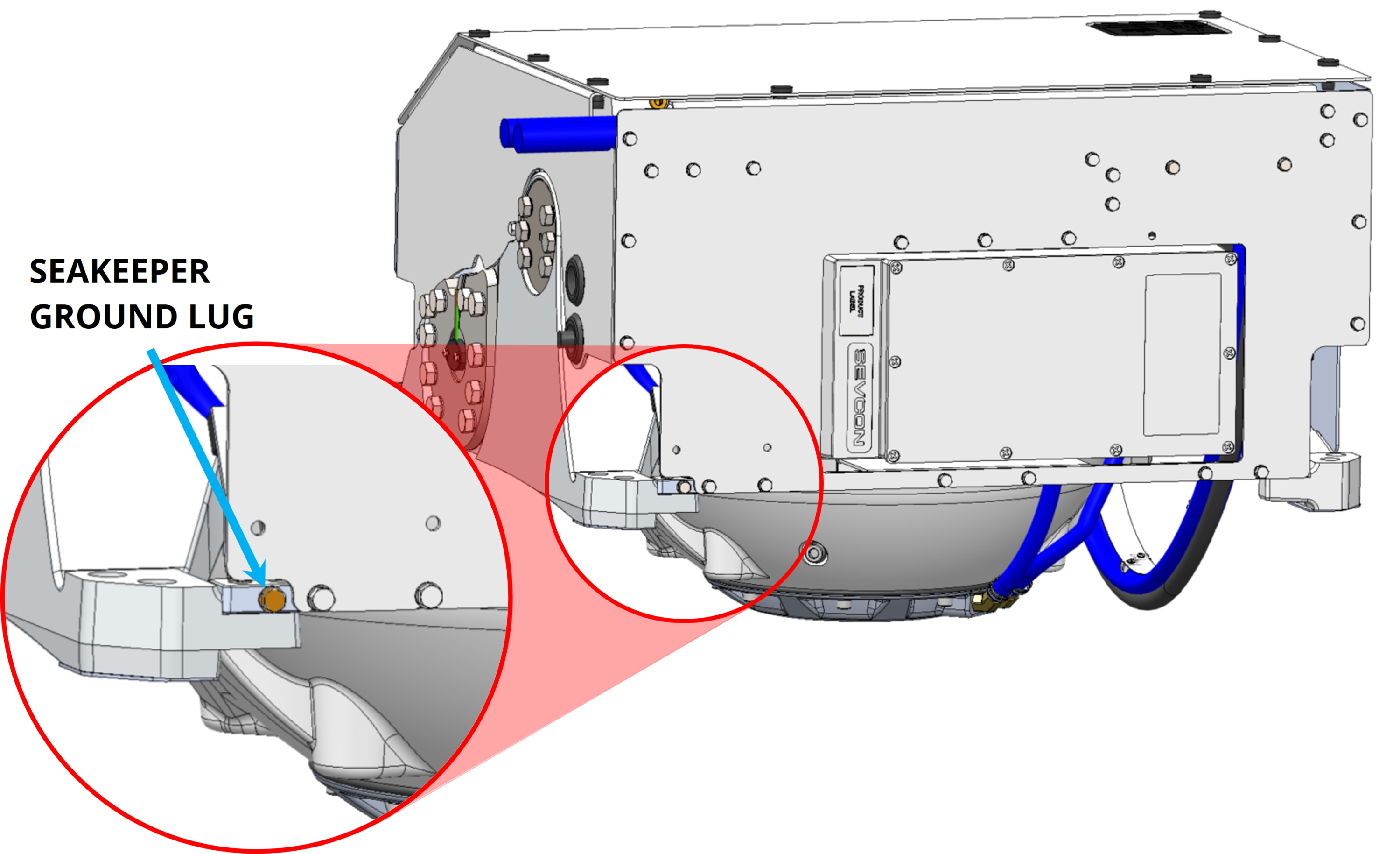
- Ground should be made with the vessel bonding system, if available. However, the ground is not referring specifically to a bonding system but for outboard boats generally refers to the outboard engine negative terminal. Per ABYC E-11 (2018), Clause 11.5.2.7.4: If the negative side of the DC system is to be connected to the ground, the connection shall be made only from the engine negative terminal, or its bus, to the DC grounding bus. This connection shall be used only as a means of maintaining the negative side of the circuit at ground potential and is not to carry current under normal operating conditions.
- A proper ground connection is critically important for corrosion protection and helps to ensure the ignition protection of the unit by ensuring it does not carry any stray current.

3.6 ConnectBox Connections
Reference Documents:
- 90696 – Seakeeper 4.5 Cable Block Diagram
- 90699 – Seakeeper 4 Cable Block Diagram
- Seakeeper MFD Compatibility Technical Bulletins:
- Optional 5″ Touch Display
Seakeeper 4 / 4.5 Display Options
A Seakeeper display is required with the installation of a Seakeeper 4 / 4.5 to support the full functionality of the unit through the Seakeeper App in addition to the ConnectBox. The Seakeeper App provides an interface for controlling the Seakeeper or viewing the Settings, Service, Info, and Alarm pages. The Seakeeper ConnectBox can be helm-mounted to provide an additional interface for the control of the Seakeeper but does not replace the need for a Seakeeper compatible display.
The Seakeeper 4 and 4.5 have two options for establishing a Seakeeper display interface to support the Seakeeper App:
- Connect the Seakeeper to a compatible Multifunction Display (MFD).
- Install an optional Seakeeper 5″ Touch Display (P/N 90600).
The following figure provides a schematic of the two display options. The subsequent sections outline the instructions and references for connecting the Seakeeper to each of these display options.

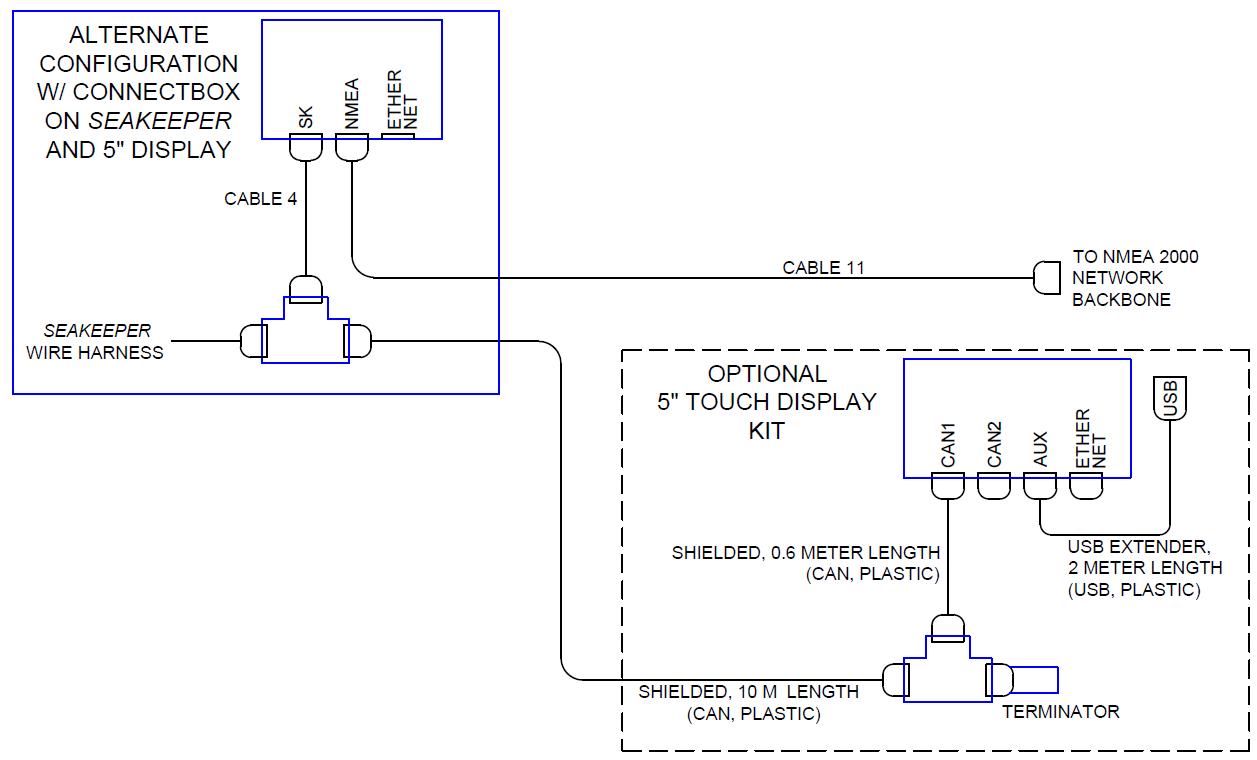
Connecting to a Compatible MFD
- The Seakeeper 4 / 4.5 can be connected to a variety of available MFD systems. Refer to the Technical Bulletins Section of the Seakeeper Technical Library for manufacturer specific MFD compatibility technical bulletins.
- MFD specific Technical Bulletins will be updated regularly as new MFD systems become compatible. Currently GARMIN, RAYMARINE, SIMRAD, and FURUNO offer compatible MFD models.
- Once a compatible MFD has been selected, refer to the appropriate manufacturer specific Technical Bulletin for integration instructions.
- Connect Seakeeper-supplied Ethernet adapter cable 10, D-Code 10 m cable to MFD manufacturer-specific Ethernet adapter cable. Custom Ethernet cables for specific MFD manufacturers are available through Seakeeper and must be purchased with the Seakeeper if connecting to an MFD.
Connecting to an Optional Seakeeper 5″ Touch Display
If not utilizing a compatible MFD display, a Seakeeper 5” Touch Display must be purchased from Seakeeper. The Seakeeper 5” Touch Display (P/N 90600) includes the components shown in the following figure and will be integrated with the ConnectBox.
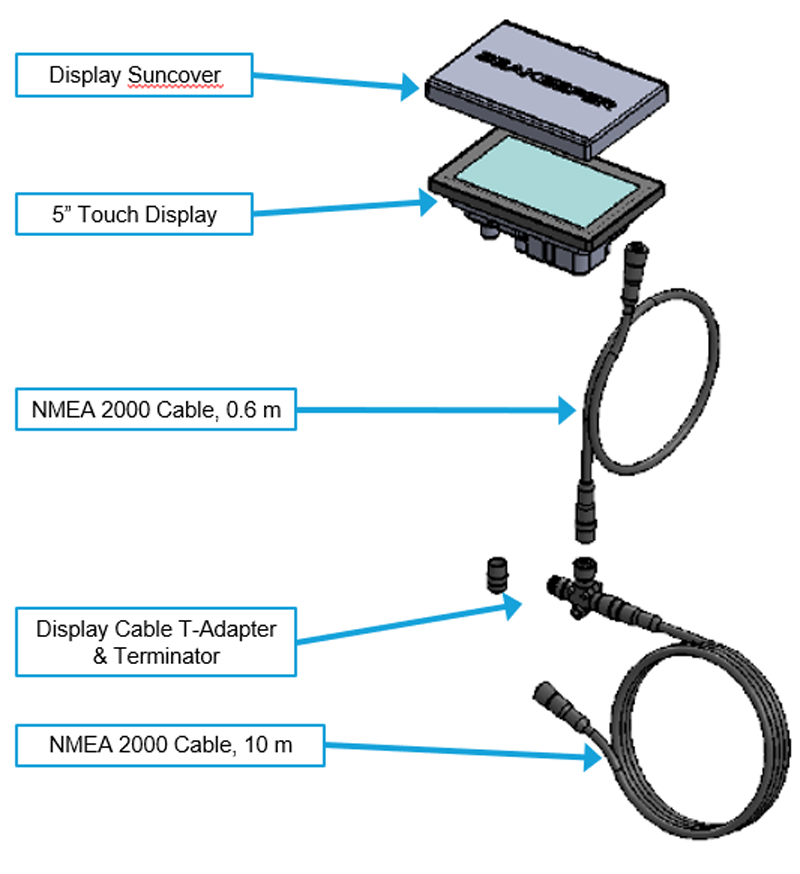
(P/N 90600)
- Determine location of Seakeeper 5” Touch Display:
- The desired location of the 5” Touch Display must be determined with respect tothe vessel’s arrangement.
- The 5” Touch Display should be located on or near the helm or another easily accessible location.
- Route CAN communications cable:
- The CAN Cable, (labelled NMEA 2000 Cable in figure), is a 10 m shielded cable that connects the ConnectBox Tee adapter to the 5” Touch Display.
- The NMEA 2000 cable must be routed and installed in the vessel from the Seakeeper wire harness CAN Tee to the Tee Adapter at the Seakeeper 5” Touch Display, included with P/N 90600.
- Install Seakeeper 5″ Touch Display equipment:
- Console space required: Approx. 5.24 W x 3.70 H in. (133 x 94 mm)
- Mounting Instructions, Surface Mount: see Envelope and Mounting Details, in Drawing No. 90438 – 5” Display Envelope and Mounting Details.
- CAN communications tee adapter and terminator mounting instructions:
- Console space required, Rear: Approx. 4 W x 3 H in. (102 x 76 mm)
- Mounting Instructions: Rear mount on vessel console panel, within 2 ft (0.6 m) of Display.
- Hardware required: One mounting screw for .197 in. (5 mm) diameter mounting hole on Tee Adapter.
- Connect Seakeeper 5” Touch Display Equipment:
- The Seakeeper 5” Touch Display is connected in accordance with the figure above.
NMEA 2000 Network Connection
The Seakeeper 4 / 4.5 requires a connection to the vessel’s NMEA 2000 network backbone. The Seakeeper will monitor information on the NMEA network to support and optimize the performance of the Seakeeper.
- Install customer-supplied NMEA 2000 Tee Adapter (space required: approximately 4 W X 3 H in. (102 X 76 mm).
- Connect NMEA Backbone to Tee Adapter.
- Connect Seakeeper-supplied NMEA CAN cable to the customer-supplied NMEA 2000 Tee Adapter on vessel’s NMEA 2000 backbone.
- An active NMEA 2000 compatible GPS signal is required on the vessel’s NMEA 2000 backbone to operate the Seakeeper.
- If no GPS signal is detected, a warning will be present on the Seakeeper app.
- An active NMEA 2000 compatible GPS signal is required on the vessel’s NMEA 2000 backbone to operate the Seakeeper.
ConnectBox Helm Mounting – Optional
- Console space required: Approx. 3.41 L x 4.15 W in. (87 x 106 mm).
- Mounting Instructions, Surface Mount: See Drawing No. 90558 – Seakeeper ConnectBox Helm Mounting Kit, for details. Seakeeper ConnectBox 3D Model available upon request.
- Mount ConnectBox Replacement Blank insert into Seakeeper 6 / 5 top cover at the original location of the ConnectBox.
4.0 Cooling Installation
4.1 Cooling Installation Introduction
The Seakeeper 4 / 4.5 is shipped with the cooling circuit filled and ready for use. Only a quick confirmation of glycol level is required.
Reference Documents:
- 90696 – Seakeeper 4.5 Cable Block Diagram
- 90699 – Seakeeper 4 Cable Block Diagram
- 90802 – Seakeeper 4 / 4.5 Cooling Water Schematic
- 30331 – Seakeeper DC Seawater Pump Assembly
- TB-90191 – Seawater Cooling Pump Recommendations

4.2 Installation Considerations
- Installer is responsible for supplying a dedicated seawater pump and associated plumbing. Seawater connections on the heat exchanger mate with ¾ in. (19 mm) hose. An optional seawater pump can be purchased through Seakeeper, P/N 30331.
- There is no need to disconnect hose from glycol pump except to replace the pump. In this case, provision will need to be made to catch draining glycol as plumbing is disconnected. Use caution to avoid breaking plastic hose connections on pump casing.
- The seawater pump is powered by Seawater Pump Output Cable, via “SEAWATER OUT” on the Seakeeper, as outlined in Electrical Installation Section.
- This pump must operate on 12 VDC, 15 A (OR OPTIONAL 24 VDC, 10 A on Seakeeper 4.5) power. Pumps requiring other voltages or higher current can still be controlled by using this supply to trigger an installer-supplied contactor but a separate source of power must be provided.
- A dedicated through-hull fitting should be installed for each Seakeeper unit onboard the vessel to ensure sufficient seawater flow to each unit.
- It is recommended that the seawater pump is located below the waterline, as close to the baseline of the vessel as practically possible, to maintain positive inlet pressure on the pump in all operating conditions.
- A self-priming seawater pump is recommended to maintain water flow in all underway conditions. Cavitation can occur at the seawater inlet and potentially cause an air-lock condition restricting seawater flow to the heat exchanger.
- Vented loops are optional and should only be considered with centrifugal style pumps. Self-priming or positive displacement style pumps do not require a vented loop, this includes Seakeeper P/N 30331.
- Maximum seawater pressure in heat exchanger is 20 psi (1.4 bar).
- Seawater flow requirement through heat exchanger is 2.5 GPM (9.5 LPM) minimum and 4 GPM (15.1 LPM) maximum under all operating conditions of the boat. When sizing seawater pump, installer should factor in losses for raw water plumbing. In addition to initial operation at dock, new installations should be checked to be within the flow requirements while vessel is at speed. Flows higher than 4 GPM (15.1 LPM) could affect heat exchanger life.
4.3 Connecting Seawater to Heat Exchanger
Refer to Figure 2 or Seakeeper 4.5 Cooling Water Schematic for typical plumbing arrangement.
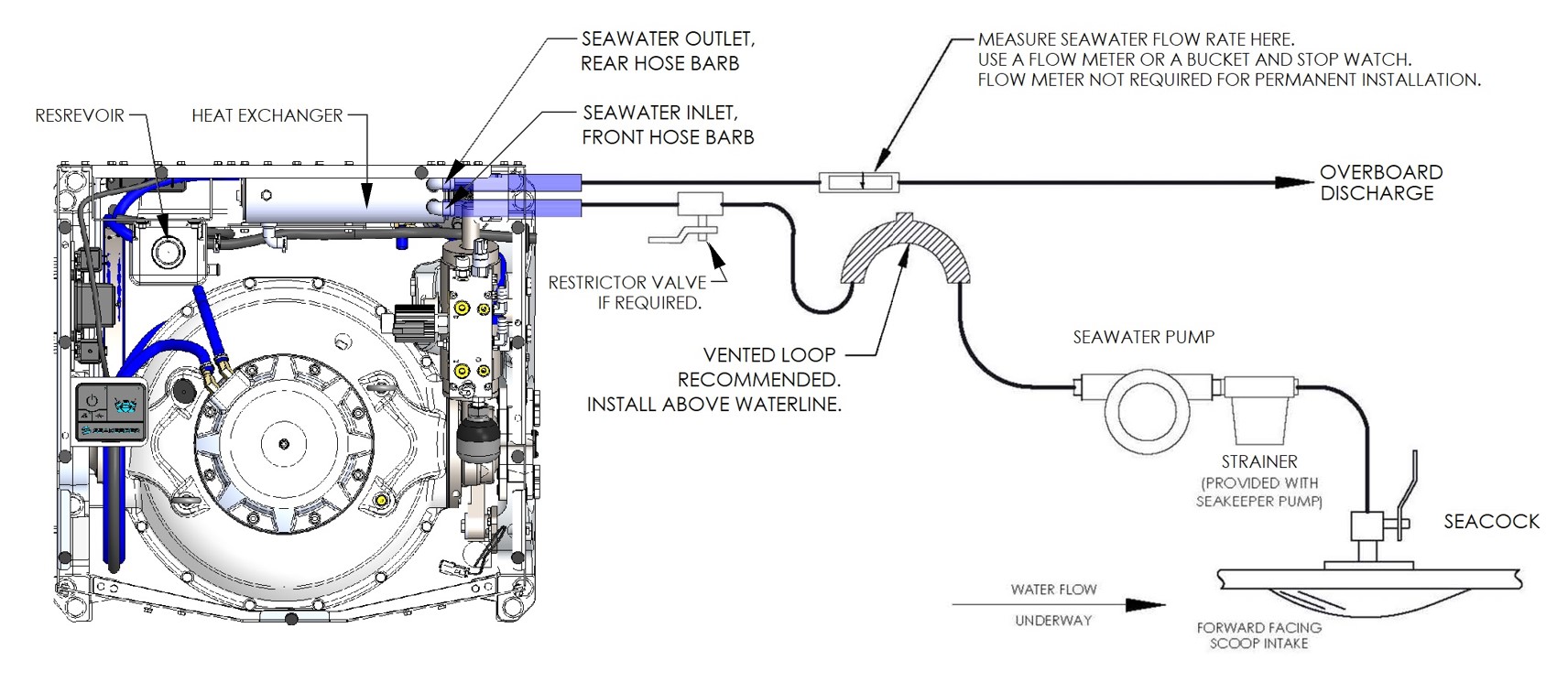
Connecting Seawater to Heat Exchanger
- Connect seawater pump to Seakeeper dedicated through-hull fitting. A strainer and seacock valve should generally be installed between the seawater inlet and the pump.
- Connect seawater from installer-supplied pump to lower ¾ in. (19 mm) hose barb on heat exchanger. Use the same practices as other below waterline seawater plumbing. Required flow rate is 2.5 GPM (9.5 LPM) minimum and 4 GPM (15.1 LPM) maximum.
- Connect seawater discharge (upper hose barb) to overboard drain. Use the same practices as other below waterline seawater plumbing.
- In addition to initial operation at dock, new installations should be checked for minimum 2.5 GPM (9.5 LPM) flow while vessel is at speed and when backing down.
- If no other method of confirming flow is available, discharge line may be temporarily diverted to a bucket. Flow is calculated from time to fill a known volume.
- A self-priming seawater pump (customer/installer supplied) may be required due to installation location to maintain water flow in all underway conditions where cavitation may occur and potentially cause an air-lock condition restricting seawater flow to the heat exchanger.
- Inspect raw water plumbing after sea trial for any signs of leakage.
- Heat exchanger contains removable end-caps to provide access for cleaning the tube bundle.
Seakeeper Optional DC Seawater Pump (P/N 30331)
Seakeeper offers a self-priming DC Seawater pump as an optional addition, P/N 30331–DC Seawater Pump Assembly, shown in Figure 3. The Seakeeper Seawater Pump is a 24 VDC pump operated at 12 VDC for the
Seakeeper. The pump assembly is pre-wired for connection to Seakeeper Seawater Pump Output Cable and includes a seawater strainer and various fittings. The pump specifications are as follows:
NOTE: Use only SeaFlo-provided threaded fittings for DC Seawater Pump 30331.
| Voltage | 24 VDC (Operate at 12 V for Seakeeper 4 and 4.5) |
| Rated Flow | 2.5 – 4 GPM (9.5 – 15.1 LPM) |
| Overcurrent Protection Rating | 15 A |
| Ignition Protection | ISO 8846 or equivalent |
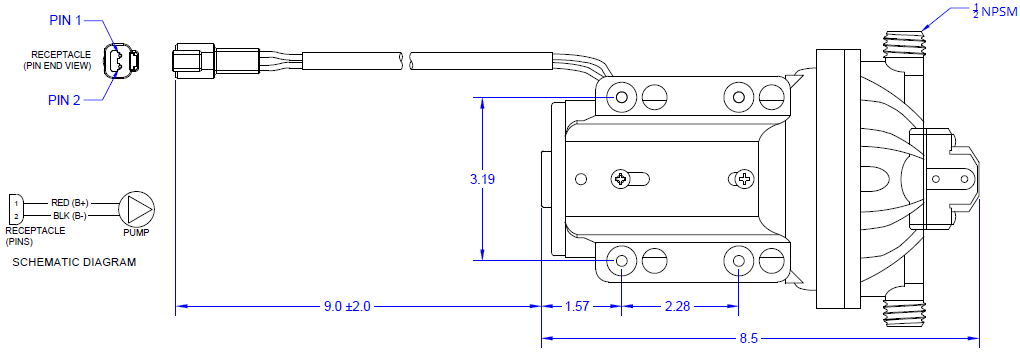
4.4 Adding Coolant
- Cooling system is filled to proper level when shipped, with a mixture of 50% ethylene glycol and 50% distilled water. The clear tube between heat exchanger and reservoir should be filled with green coolant mixture. If level has dropped, check for evidence of leaks at all connections before adding fluid as described below. If coolant is at the correct level, skip to Section: Connecting Seawater to Heat Exchanger.

- Mix 50% ethylene glycol with 50% distilled water in a clean container. Refer to Table 1or glycol manufacturer’s literature for freezing points.

- Pour mixture in until level reaches below the fill neck of reservoir as shown in Figure 3. Filling reservoir above this level will not cause any damage but coolant may be expelled from pressure relief port in cap due to normal thermal expansion of coolant.
- Connect 12 V to Seakeeper 12 VDC Input.
- At the Display, check for any ALARMS.
- Operate glycol pump by override on display.
- On menu bar, select the Service Page (wrench icon).
- Hold the wrench icon for 3 – 5 seconds to reveal the override screeen.
- Select “Glycol Override.”
- Recheck glycol level with fluid circulating in coolant circuit. Ensure level above upper port in reservoir as shown in Figure 3. Replace cap.
- Deactivate “Glycol Override.”
- The cooling system is self-purging. If small amounts of air are in the system, they will most likely be dislodged during the first sea trial. Re-check level after sea trial and add fluid if required.
NOTE: Some air may remain in coolant (cloudy appearance).
This entrained air is acceptable and normal.
5.0 Installation Requirements
5.1 Installation Requirements Introduction
The Installation Requirements section outlines the components and tools needed for the Seakeeper 4 / 4.5 installation that are not included within the scope of supply.
5.2 Required Supplies for Installation
Table 1 outlines the customer-supplied components required for the Seakeeper 4.5 installation. Part numbers are provided for items available through Seakeeper.
TABLE 1: Items not provided by Seakeeper
| Item | Description | Qty | Manual Reference | Other Reference | System |
| 1 | Spreader Bar for lifting Seakeeper | 1 | Transport & Unpacking | P/N 11766 | Mechanical |
| 2 | Seakeeper 4.5 Installation Fixture | 1 | Mechanical Installation | Dwg 90XXX | Mechanical |
| 3 | Threaded insert: Mxx-x X xx Dia (xx mm) | 8 | Mechanical Installation | Dwg 90726 | Mechanical |
| 4 | Seakeeper 4.5 Optional Thru-Bolt Kit | 1 | Mechanical Installation | P/N 90XXX | Mechanical |
| 5 | Marine Sealant | AR | Mechanical Installation | Dwg 90726 | Mechanical |
| 6 | Nickel-based Anti-Seize | AR | Mechanical Installation | Dwg 90726 | Mechanical |
| 7 | Soundproofing considerations | AR | Selection of Installation Location | Mechanical | |
| 8 | Hose Clamps for seawater plumbing (2 per hose barb) | 4 | Connecting Seawater to Heat Exchanger | Cooling | |
| 9 | Circuit Breaker, AC, 2-pole, (30 A to be used with 110-120 VAC, OR 20 A to be used with 208-230 VAC) | 1 | Electrical Equipment Power Connections | Dwg 90696 | Electrical |
| 10 | Circuit Breaker, DC, 1-Pole, 15 A | 2 | Electrical Equipment Power Connections | Dwg 90696 | Electrical |
| 11 | M6 Terminal lug for grounding Seakeeper at rear brace | 1 | Electrical Equipment Ground Connections | Electrical | |
| 12 | Cable, 10 AWG, for ground | AR | Electrical Equipment Ground Connections | Electrical | |
| 13 | Seawater Pump, 12 VDC | 1 | Electrical Equipment Power Connections | Electrical |
Dwg = Drawing
TABLE 2
| Item | Description | Use |
| 1 | Wire Cutter | DC and AC power cables |
| 2 | Wire Stripper | DC and AC power cables |
| 3 | 10 and 13 mm Socket Wrench | Cover Panels and ground stud |
| 4 | Slot Screwdriver, 5/64 in. | Field assembly connectors |
| 5 | 1/4 in. Nut Driver | Hose clamps |
| 6 | Terminal or Quick Disconnect Crimper | Power cables |
| 7 | Utility Knife | Scoring cable jackets |
| 8 | Hoist, Forklift, or Crane | Unpacking and lifting Seakeeper into position |
| 9 | Transfer Punch Kit | Locate foundation hole penetrations |
| 10 | Drill / Drill Press | Bolt hole penetrations |
| 11 | Threaded Insert Installation Kit | Tap and install threaded inserts for blind hole installations |
| 12 | 1/2″ Drive Torque Wrench | Foundation mounting screws |
| 13 | Heat Gun | Cable heat shrink |
| 14 | Fish Tape | Cable pulls |
| 15 | Hole Saw | Thru-hull fittings |
5.3 Tools Required for Installation
TABLE 2
| Item | Description | Use |
| 1 | Wire Cutter | DC and AC power cables |
| 2 | Wire Stripper | DC and AC power cables |
| 3 | 10 and 13 mm Socket Wrench | Cover Panels and ground stud |
| 4 | Slot Screwdriver, 5/64 in. | Field assembly connectors |
| 5 | 1/4 in. Nut Driver | Hose clamps |
| 6 | Greenlee K05-Synchro Crimp Tool, or equivalent | Ground cable |
| 7 | Utility Knife | Scoring cable jackets |
| 8 | Hoist, Forklift, or Crane | Unpacking and Lifting Seakeeper 4.5 into position |
| 9 | Drill/Drill Press | Bolt hole penetrations |
| 10 | 1/2 in. Drive Torque Wrench | Foundation bolt torqueing |
| 11 | 22 mm Socket Wrench | Foundation bolts |
| 12 | Heat Gun | For conductor heat shrink |
| 13 | Hole Saw | Through-hull seawater fittings |
6.0 Installation and Start Up Checklist
6.1 Installation and Start Up Checklist Introduction
Reference Documents:
- 90XXX – Seakeeper 4 / 4.5 Bolt-In Details
- 90696 – Seakeeper 4.5 Cable Block Diagram
- 90699 – Seakeeper 4 Cable Block Diagram
- 90802 – Seakeeper 4.5 Cooling Water Schematic
- 90437 – Seakeeper Commissioning Form
- SWI-105 – Commissioning Checklist
- 90XXX – Seakeeper 4 Operation Manual
- 90XXX – Seakeeper 4.5 Operation Manual
- 90569 – Seakeeper ConnectBox and Application Quick Start Guide
The Installation and Start Up Checklist section provides an overview of the primary steps covered in the installation manual and should be referenced throughout the installation process. Upon completion of the
Seakeeper 4 / 4.5 installation, the installer should commission each Seakeeper unit with the Seakeeper Commissioning Form (90437). The Commissioning Checklist Work Instruction (SWI-105) provides a checklist of items to inspect and verify during the commissioning process and serves as a supplement to the Seakeeper
Commissioning Form (90437).
All Seakeeper stabilizers should be commissioned to verify installation specifications and requirements have been implemented properly. The commissioning process should include completion of the Seakeeper
Commissioning Form (90437), all the items in the Installation Checklist, and verification of Seakeeper operation without alarms or abnormal behavior.
6.2 Installation Checklist
6.2.1 Mechanical Checklist
![]() Seakeeper foundation installed per requirements of Drawing No. 90XXX –
Seakeeper foundation installed per requirements of Drawing No. 90XXX –
Seakeeper 4.5 Bolt-In Installation Details.
Structure designed to accommodate Seakeeper 4.5 forces, as defined in
Drawing 90XXX – Seakeeper 4.5 Bolt-In Details, with a minimum safety
factor of 2.0.
Foundation is coplanar within 0.06 in. (1.5 mm).
![]() Clearances around Seakeeper meet service and operating specifications
Clearances around Seakeeper meet service and operating specifications
and no obstructions are within the Seakeeper envelope.
![]() Seakeeper 4.5 Bolt-In Kit is installed (P/N 90XXX).
Seakeeper 4.5 Bolt-In Kit is installed (P/N 90XXX).
![]() Foundation bolts torqued to specification: XXX ft-lbs (XXX Nm).
Foundation bolts torqued to specification: XXX ft-lbs (XXX Nm).
6.2.2 Electrical Checklist
![]() Ground Cable (Customer Supplied) ground cable connected on both ends.
Ground Cable (Customer Supplied) ground cable connected on both ends.
![]() 12 VDC Control Power Cable (Seakeeper Supplied)
12 VDC Control Power Cable (Seakeeper Supplied)
Connect wire end to 12 VDC power at customer-supplied connection
box or directly to circuit breaker.
Plug connector of Cable 1 into mating connector on Seakeeper wire
harness (INPUT POWER).
![]() Seawater Pump Input Power Cable (Seakeeper Supplied)
Seawater Pump Input Power Cable (Seakeeper Supplied)
Connect wire end to 12 VDC power at customer-supplied connection
box or directly to circuit breaker.
Plug connector of Cable 9 into mating connector on Seakeeper wire
harness (SW PUMP VDC IN).
![]() Seawater Pump Output Cable (Seakeeper Supplied)
Seawater Pump Output Cable (Seakeeper Supplied)
Connect Cable 5 from SW PUMP VDC OUT to customer-supplied
12 VDC seawater pump.
SEAKEEPER DISPLAY CONNECTION
![]() Ensure one of the following display options is installed:
Ensure one of the following display options is installed:
Option 1: Compatible MFD (refer to Seakeeper MFD Compatibility
Technical Bulletins)
Option 2: Seakeeper 5″ Touch Display (P/N 90600)
NMEA 2000 NETWORK CONENCTION
![]() Required GPS signal on NMEA 2000 backbone
Required GPS signal on NMEA 2000 backbone
![]() Connect NMEA CAN Cable to ConnectBox NMEA port.
Connect NMEA CAN Cable to ConnectBox NMEA port.
![]() Connect NMEA CAN Cable to vessel NMEA backbone.
Connect NMEA CAN Cable to vessel NMEA backbone.
6.2.3 Cooling Checklist
![]() Install 12 VDC seawater pump capable of required flow rates
Install 12 VDC seawater pump capable of required flow rates
(Seakeeper 4.5 may operate a 24 VDC Seawater Pump).
Optional seawater pump can be purchased through Seakeeper (P/N 30331)
![]() Route and connect seawater inlet and outlet hoses per 90802 – Seakeeper 4 / 4.5
Route and connect seawater inlet and outlet hoses per 90802 – Seakeeper 4 / 4.5
Cooling Water Schematic.
![]() Test seawater pump with Seawater Override
Test seawater pump with Seawater Override
Verify 2.5 GPM (9.5 LPM) minimum and 8 GPM (30 LPM) maximum flow rate.
![]() Verify coolant level at bottom of filler neck in reservoir.
Verify coolant level at bottom of filler neck in reservoir.
6.3 Start Up Checklist
Refer to Seakeeper 4 / 4.5 Operation Manual for detailed start up instructions.

Prior to beginning the start up sequence all previous Sections of the Installation Manual for Mechanical, Electrical, and Cooling installation must be complete.
Before continuing, the Seakeeper cover must be installed and the operating clearances must be clear of personnel and equipment.
| CHECK | REQUIREMENT TO BE MET |
| Remove lifting eyebolts and install sealing bolts (M10-1.25 X 12 mm) and flat washers into lifting eyeholes and install cover. | |
| FOR SEAKEEPER 4: Energize battery isolation switch, high-current 100 A breaker. | |
| FOR SEAKEEPER 4.5: Supply 110-230 VAC to Motor Drive Box at customer-supplied electrical disconnect. | |
| Energize low-current 15 A breaker, and seawater pump breaker. | |
| Verify Seakeeper display is active and no alarms present. | |
| Check that battery voltage exceeds 12 VDC. FOR SEAKEEPER 4: A minimum battery voltage of 11 VDC is required for the duration of Seakeeper spool-up. | |
| Override seawater pump “ON” and verify flow at seawater outlet. (To activate override, at 0 RPM flywheel speed, hold down SERVICE button wrench icon for 5 seconds to reveal override screen) | |
| Deactivate seawater pump when completed obtaining seawater flow rate. | |
| Press Seakeeper ON/OFF Button and follow instructions in Seakeeper Operation Manual for complete start-up instructions. | |
| Verify no alarms are present. | |
| Power Seakeeper down, the Seakeeper flywheel will take 2+ hours to coast down to 0 RPM. |
7.0 Revision History
| Revision | Description | Date |
| 1 | Initial Release | 09NOV2023 |